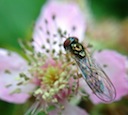 There are many species of hoverfly in the UK. While most are known only by their scientific name, this one is distinguished by having a common name of its own.
There are many species of hoverfly in the UK. While most are known only by their scientific name, this one is distinguished by having a common name of its own.
Photo: Amanda Scott
Scientific name: Melanostomer scalare
Common name: Chequered Hoverfly
There are over 280 species of hoverfly in Great Britain, many of which (though not all) are characterised by their highly recognisable bright yellow and black patterning, mimicking wasps and bees (known as Bartesian mimicry) and therefore, although harmless, deterring predators. Their ability to hover in flight, either when nectaring or, in males, when searching/waiting for a mate, is also a very familiar feature.
The Chequered Hoverfly – Melanostomer scalare – is widespread across Britain and Ireland, and has a long flight period, from April to October. It is also one of the very few with a common name.
Many hoverflies, which are true flies (Diptera), can be very difficult to distinguish to species level unless using a microscope. Even the relatively common M. scalare can be confused with its close relative M. mellinum in the field. Hoverflies have what are called dust spots – two approximately triangular patches at the top of their head between their compound eyes – and these are much broader in female M. scalare than in M. mellinum (not really visible in the photos of the female M. scalare shown here). Melanostomer scalare males have a more elongated abdomen than in M. mellinum.
The Chequered Hoverfly is most often found in woodland edges and rides and in grassland, feeding on the pollen of grasses and sedges and other wind-pollinated plants, which provide a plentiful source of food. The larvae, which usually hatch only a few days after the eggs are laid, feed on aphids close to the ground.
Melanostomer species, together with Platycheirus, are particularly susceptible to infection by the fungus Entomophthora muscae, which grows inside them, eventually emerging from between their body plates forming distinctive white bands. Hoverflies afflicted by E. muscae are most likely to be found in the later summer and autumn, fixed to plants and usually dead, often in some numbers when the fungus has spread rapidly between individuals.
Did you know…?
…Globally, there are some 6000 species of hoverfly in 200 genera
…Hoverflies are welcomed by gardeners, as the larvae will eat and therefore help control aphids. Adults are particularly attracted to native plants, so including these in planting schemes will help encourage hoverflies.

More information and references:
Ball, S. and Morris, R., 2013. Britain’s Hoverflies: An Introduction to the Hoverflies of Britain. Princeton University Press, Woodstock, Oxfordshire.
Chinery, M., 2005. Collins Complete Guide to British Insects. HarperCollins, London.
Published: October 2013
Author: Amanda Scott
Photos: Amanda Scott
